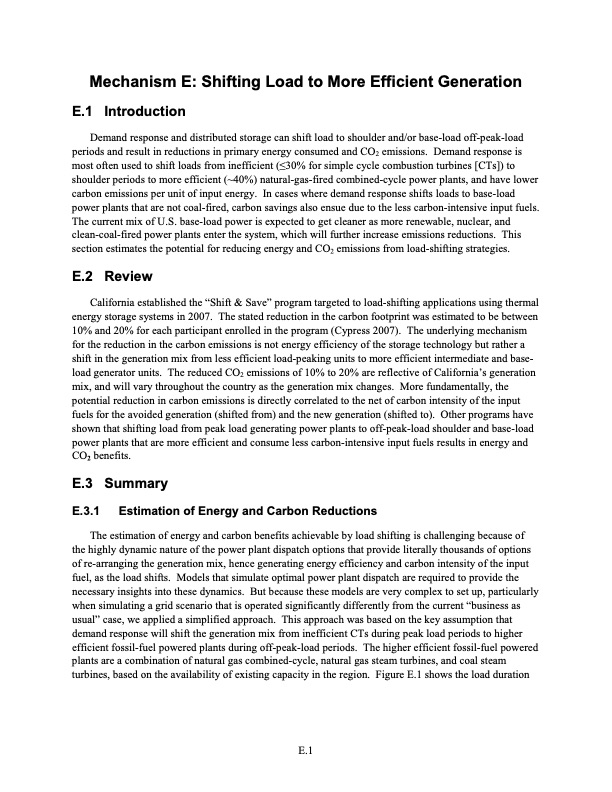
PDF Publication Title:
Text from PDF Page: 111
Mechanism E: Shifting Load to More Efficient Generation E.1 Introduction Demand response and distributed storage can shift load to shoulder and/or base-load off-peak-load periods and result in reductions in primary energy consumed and CO2 emissions. Demand response is most often used to shift loads from inefficient (≤30% for simple cycle combustion turbines [CTs]) to shoulder periods to more efficient (~40%) natural-gas-fired combined-cycle power plants, and have lower carbon emissions per unit of input energy. In cases where demand response shifts loads to base-load power plants that are not coal-fired, carbon savings also ensue due to the less carbon-intensive input fuels. The current mix of U.S. base-load power is expected to get cleaner as more renewable, nuclear, and clean-coal-fired power plants enter the system, which will further increase emissions reductions. This section estimates the potential for reducing energy and CO2 emissions from load-shifting strategies. E.2 Review California established the “Shift & Save” program targeted to load-shifting applications using thermal energy storage systems in 2007. The stated reduction in the carbon footprint was estimated to be between 10% and 20% for each participant enrolled in the program (Cypress 2007). The underlying mechanism for the reduction in the carbon emissions is not energy efficiency of the storage technology but rather a shift in the generation mix from less efficient load-peaking units to more efficient intermediate and base- load generator units. The reduced CO2 emissions of 10% to 20% are reflective of California’s generation mix, and will vary throughout the country as the generation mix changes. More fundamentally, the potential reduction in carbon emissions is directly correlated to the net of carbon intensity of the input fuels for the avoided generation (shifted from) and the new generation (shifted to). Other programs have shown that shifting load from peak load generating power plants to off-peak-load shoulder and base-load power plants that are more efficient and consume less carbon-intensive input fuels results in energy and CO2 benefits. E.3 Summary E.3.1 Estimation of Energy and Carbon Reductions The estimation of energy and carbon benefits achievable by load shifting is challenging because of the highly dynamic nature of the power plant dispatch options that provide literally thousands of options of re-arranging the generation mix, hence generating energy efficiency and carbon intensity of the input fuel, as the load shifts. Models that simulate optimal power plant dispatch are required to provide the necessary insights into these dynamics. But because these models are very complex to set up, particularly when simulating a grid scenario that is operated significantly differently from the current “business as usual” case, we applied a simplified approach. This approach was based on the key assumption that demand response will shift the generation mix from inefficient CTs during peak load periods to higher efficient fossil-fuel powered plants during off-peak-load periods. The higher efficient fossil-fuel powered plants are a combination of natural gas combined-cycle, natural gas steam turbines, and coal steam turbines, based on the availability of existing capacity in the region. Figure E.1 shows the load duration E.1PDF Image | The Smart Grid: An Estimation of the Energy and CO2 Benefits

PDF Search Title:
The Smart Grid: An Estimation of the Energy and CO2 BenefitsOriginal File Name Searched:
PNNL-19112.pdfDIY PDF Search: Google It | Yahoo | Bing
NFT (Non Fungible Token): Buy our tech, design, development or system NFT and become part of our tech NFT network... More Info
IT XR Project Redstone NFT Available for Sale: NFT for high tech turbine design with one part 3D printed counter-rotating energy turbine. Be part of the future with this NFT. Can be bought and sold but only one design NFT exists. Royalties go to the developer (Infinity) to keep enhancing design and applications... More Info
Infinity Turbine IT XR Project Redstone Design: NFT for sale... NFT for high tech turbine design with one part 3D printed counter-rotating energy turbine. Includes all rights to this turbine design, including license for Fluid Handling Block I and II for the turbine assembly and housing. The NFT includes the blueprints (cad/cam), revenue streams, and all future development of the IT XR Project Redstone... More Info
Infinity Turbine ROT Radial Outflow Turbine 24 Design and Worldwide Rights: NFT for sale... NFT for the ROT 24 energy turbine. Be part of the future with this NFT. This design can be bought and sold but only one design NFT exists. You may manufacture the unit, or get the revenues from its sale from Infinity Turbine. Royalties go to the developer (Infinity) to keep enhancing design and applications... More Info
Infinity Supercritical CO2 10 Liter Extractor Design and Worldwide Rights: The Infinity Supercritical 10L CO2 extractor is for botanical oil extraction, which is rich in terpenes and can produce shelf ready full spectrum oil. With over 5 years of development, this industry leader mature extractor machine has been sold since 2015 and is part of many profitable businesses. The process can also be used for electrowinning, e-waste recycling, and lithium battery recycling, gold mining electronic wastes, precious metals. CO2 can also be used in a reverse fuel cell with nafion to make a gas-to-liquids fuel, such as methanol, ethanol and butanol or ethylene. Supercritical CO2 has also been used for treating nafion to make it more effective catalyst. This NFT is for the purchase of worldwide rights which includes the design. More Info
NFT (Non Fungible Token): Buy our tech, design, development or system NFT and become part of our tech NFT network... More Info
Infinity Turbine Products: Special for this month, any plans are $10,000 for complete Cad/Cam blueprints. License is for one build. Try before you buy a production license. May pay by Bitcoin or other Crypto. Products Page... More Info
| CONTACT TEL: 608-238-6001 Email: greg@infinityturbine.com | RSS | AMP |